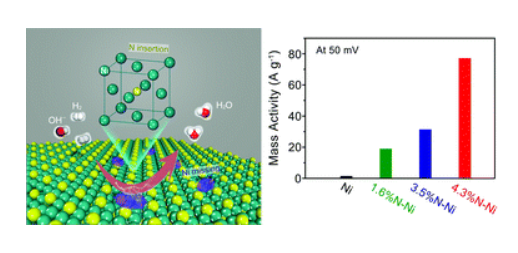On January 26, the research group led by Prof. Wang Deli of the School of Chemistry and Chemical Engineering and Key Laboratory of Material Chemistry for Energy Conversion and Storage (HUST) published an online paper entitled “Nitrogen-inserted nickel nanosheets with controlled orbital hybridization and strain fields for boosted hydrogen oxidation in alkaline electrolytes (DOI: 10.1039/D1EE03482K)” on Energy & Environmental Science.
With the crucial advantage of employing non-noble metal-based catalysts in alkaline solution, anion exchange membrane fuel cells (AEMFCs) have attracted growing attention as an economic device for hydrogen utilization. However, the kinetics of the anodic HOR is still sluggish in alkaline electrolytes with a degradation of two orders of magnitude in comparison with that in acidic electrolytes. Accordingly, it still remains a grand challenge to developing efficient and economic catalysts for the HOR in alkaline electrolytes. Here, we report a versatile strategy to fabricate nitrogen-inserted Ni nanosheets with precisely controlled orbital hybridization and strain fields for boosted HOR in alkaline electrolytes. Mechanistic studies reveal that the insertion of N in the Ni lattice induces strong d-sp orbital hybridization, which can be further enhanced by the partially released tensile strain derived from Ni–Ni coordination missing, thus leading to the optimum adsorption of critical hydrogen intermediates. Meanwhile, the existent surface strain can simultaneously strengthen the adsorption of hydroxyl species. The well-regulated adsorption behaviors of both hydrogen and hydroxyl could accelerate the rate-determining Volmer step and thus boost the HOR performance. Accordingly, the nitrogen-inserted Ni nanosheets achieve remarkable performance with a mass activity of 77.13 A g−1, which is 53 times higher than that of pure Ni nanosheets and exceeds those of most of the reported non-noble metal-based HOR catalysts. This strategy provides a promising strategy to design robust and economic catalysts for energy-related electrocatalysis through finely engineering the orbital hybridization and strain fields.

Huazhong University of Science and Technology is the author unit and corresponding unit of this paper. Prof. Zhao Xu is the first author and Prof. Wang Deli is the corresponding author. This work was supported by the National Natural Science Foundation of China (22002046 and 91963109) and the Fundamental Research Funds for the Central Universities (2020kfyXJJS063).
Link to this paper: https://pubs.rsc.org/en/content/articlelanding/2022/EE/D1EE03482K